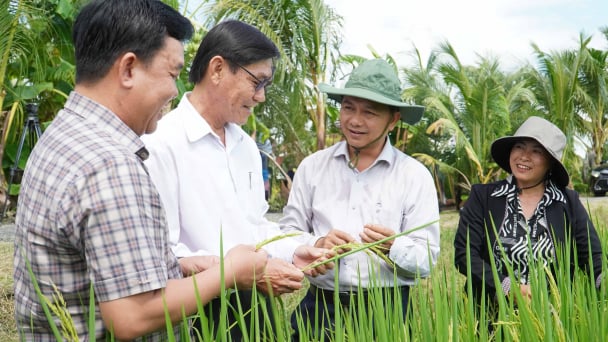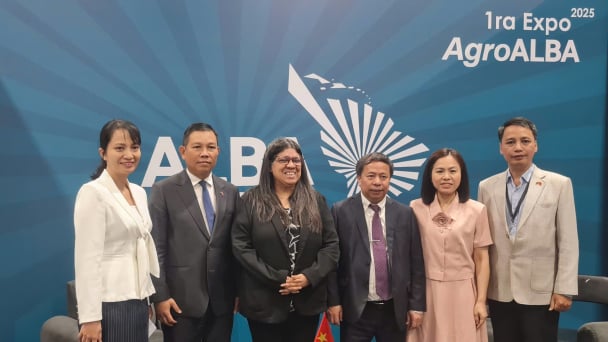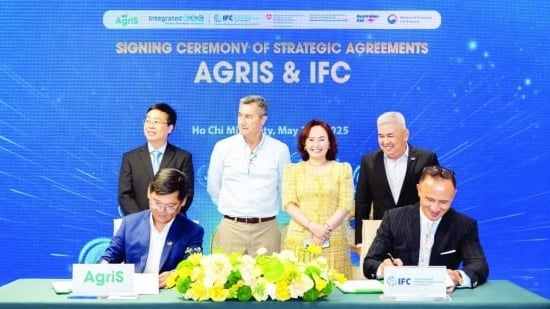June 21, 2025 | 03:58 GMT +7
June 21, 2025 | 03:58 GMT +7
Hotline: 0913.378.918
June 21, 2025 | 03:58 GMT +7
Hotline: 0913.378.918

Tran Van Hanh pioneered bringing asparagus to Bau Can commune (Chu Prong district, Gia Lai). Photo: Do Doanh.
Every day, be it rainy or full of sunshine, Mr. Tran Van Hanh and his wife in Dong Tam village, Bau Can commune, Chu Prong district (Gia Lai) always work hard on their fresh asparagus fields. Although the work is hard, the young couple is happy because asparagus has brought the family a higher and more stable income than other crops.
Mr. Tran Van Hanh shared: A few years ago, when the price of agricultural products dropped, struggling to know what to plant for high efficiency, his family, as well as many farming households in the commune, faced many hardships.
In 2017, at the age of 27, after visiting an asparagus growing model in Ninh Thuan province, he was determined to explore, learn and discuss with his family uprooting 100 old coffee trees to plant a trial 1,000 m2 of asparagus. Through investing, tending and selling products, seeing asparagus plants bring high economic efficiency, he decided to expand the area to 7,000 m2.
Asparagus only need 5 months to harvest, and the annual harvest period is nine months. On average, 1,000 m2 of asparagus yields 300 kg/month. With the current selling price (wholesale) of about VND 50,000/kg, each month the family can earn about VND 15 million/1,000 m2.
Talking about the effectiveness of growing asparagus, Mr. Tran Van Hanh excitedly shared: Asparagus plants are very suitable for the soil and climate conditions of Chu Prong in particular and the Central Highlands in general. The shoots grow very well, the product’s deliciousness and sweetness are of higher quality than in other regions.

Mr. Hanh has connected dozens of households to establish a production chain, supplying asparagus produced under VietGAP standards and is moving towards organic production. Photo: Do Doanh.
In 2020 and 2021, despite the impact of the Covid-19 epidemic, the impact from Covid-19, no matter how much asparagus Mr. Hanh's family produces, they are always "sold out". The family mainly supplies products to supermarket systems in Gia Lai and Saigon. Gon, Binh Duong.
It is known that the green asparagus product of Mr. Tran Van Hanh's family (Tran Hanh) has been certified by Gia Lai Provincial People's Committee as a provincial 3-star OCOP product. To ensure stable production, Mr. Hanh has signed a contract with consumption stores to supply green asparagus products.
In the context that agricultural products have been at low prices for many years, the asparagus growing model is a new direction to bring stable income for farmers.
Although asparagus has only appeared in Chu Prong district for about 5 years, through actual production and economic efficiency, so far in Chu Prong district, there have been 19 farmers growing asparagus with an area of almost 10 ha.
Translated by Samuel Pham
/2025/06/17/3942-2-143243_548.jpg)
(VAN) Recently, in Sweden, the Secretary of the Binh Dinh Provincial Party Committee presented the Investment Registration Certificate for the 'Polyester Fabric Recycling Complex' project to SYRE Impact-AB Company.
/2025/06/12/3721-2-202745_83.jpg)
(VAN) TH made an impression at Seoul Food 2025 with its line of natural beverages, paving the way for Vietnamese food products to enter the South Korean market.

(VAN) Soc Trang's success in rice exports stems from a strategy of developing fragrant and specialty rice cultivation areas and standardizing production toward low-emission practices.
/2025/06/11/1311-5-120811_839.jpg)
(VAN) The pig farming industry is facing the challenge of comprehensive restructuring to meet requirements for quality, safety, traceability, and market expansion both domestically and for export.

(VAN) Vietnam considers participating in ALGROALBA in order to expand agricultural production, coordinate the assessment and effective exploitation potential land.
/2025/06/05/5314-1-184727_407.jpg)
(VAN) From seemingly worthless fish scales and skin, enzymes and lactic ferments can transform by-products into peptides, opening a sustainable, effective business direction and elevating Vietnamese seafood.

(VAN) TTC AgriS and IFC signed a strategic partnership to develop a sustainable agricultural value chain, aiming to achieve the Net Zero target by 2035.